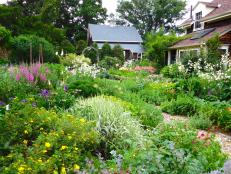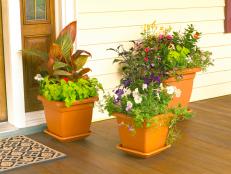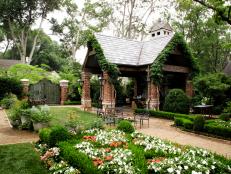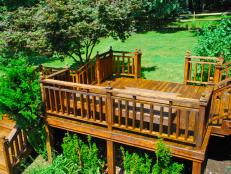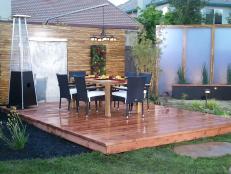Vertical Garden Design
Lift your garden to new heights by taking advantage of unused vertical space with vines, trellises and living walls.

Image courtesy of Williams Sonoma
Expand your garden upward by incorporating vertical garden design into your yard. Growing plants upwards or on walls allows you to introduce new plants into a small yard or already crammed garden. Better still, some vertical garden design embraces cutting edge techniques, if you enjoy exploring and learning new growing practices.
Vertical gardens lift plants to eye level, putting them on display in a way that’s charming and memorable. Count on vertical growing to screen ugly views, like a compost pile, chain link fence or pool pump and gear. Use vertical garden design to form living walls in an outdoor room or screen a patio, pool or seating area.
Traditional vertical garden design relies on familiar methods to elevate plants from soil to sky. A trellis provides one way to support plants on their upward journey. Trellises can be simple structures, like a trio of bamboo poles positioned and lashed together at the top to form a tepee. Or a trellis might be an arch formed from bent wood, wrought iron or curved concrete reinforcing rods. A trellis can be a modest three feet or a towering 10-foot affair.
Vines are definitely stars in vertical garden design. Depending on your location, select sun-loving perennial vines, such as clematis, trumpet vine or wisteria, or plant shade-craving vines of climbing hydrangea, hardy kiwi or sweet autumn clematis. Annual vines explode from soil and rocket heavenward, blanketing supports in a growing season. Many, like morning glory, moonflower, cardinal creeper and climbing nasturtium sprout reliably from seed tucked into garden soil.
Living walls provide another option for vertical garden design. These unusual gardens typically sprout from plastic trays divided into planting cells. The cells often slant outward, creating a shallow soil pocket and a place for plants to sink their roots. A typical 2-inch square cell provides a happy home for shallow-rooted succulents, while 4-inch square cells can host small annuals, perennials or edibles, like alpine strawberries or leaf lettuces. Consider building a custom frame for your vertical garden from rot-resistant wood to create a stunning conversation piece.
Most vertical wall specialists recommend leaving an air space between planter and wall. Plastic trays usually come with a hanging bracket that suspends the tray. Add spacer blocks along the edges and base to support the tray away from a wall. Mount living wall planters directly into stucco or concrete walls, but build a frame and use spacers to keep planters from resting directly on wooden surfaces.
Felted or plastic planting pockets offer another opportunity to craft a vertical garden design. These pockets come in different sizes to hold varying amounts of soil. Fill them with any type of plant, but try to match the final plant size to the pouch (small plants in small pouches, large plants in large ones).
Watering vertical gardens is vital and sometimes tricky. Drip irrigation probably works best to deliver water directly to soil. Look for gravity-fed systems that allow a natural flow rate. A droughty episode can destroy a vertical garden, so pay attention to plants’ water needs, especially as summer heats up and plants grow larger.
No matter what type of vertical garden design you pursue, always consider plant size. Anchor trellises deeply in soil to avoid having summer winds wrestle your vine—and trellis—to the ground. For living wall planters, always make sure the wall or fence is rated to carry the weight load of the planting frame, wet soil and plants.







